Intel Xeon Gold 6130 Benchmarks
For this exercise, we are using our legacy Linux-Bench scripts which help us see cross-platform “least common denominator” results we have been using for years as well as several results from our updated Linux-Bench2 scripts. At this point, our benchmarking sessions take days to run, and we are generating well over a thousand data points. We are also running workloads for software companies that want to see how their software works on the latest hardware. As a result, this is a small sample of the data we are collecting and can share publicly. Our position is always that we are happy to provide some free data, but we also have services to let companies run their own workloads in our lab, such as with our DemoEval service. What we do provide is an extremely controlled environment where we know every step is the same and each run is done in a real-world data center, not a test bench.
We also wanted to note that our dataset is focused on pre-Spectre and Meltdown results at this point. Starting with our Ubuntu 18.04 generation of results we will have comparison points to the new reality. The Spectre and Meltdown patches to hurt Intel’s performance in many tests. At the same time, as of writing this article, patches are still being worked on. Likewise, software is being tuned to deal with the impacts of the patches. Given this, we are going to give the ecosystem some time to settle before publishing new numbers.
Python Linux 4.4.2 Kernel Compile Benchmark
This is one of the most requested benchmarks for STH over the past few years. The task was simple, we have a standard configuration file, the Linux 4.4.2 kernel from kernel.org, and make the standard auto-generated configuration utilizing every thread in the system. We are expressing results regarding compiles per hour to make the results easier to read.
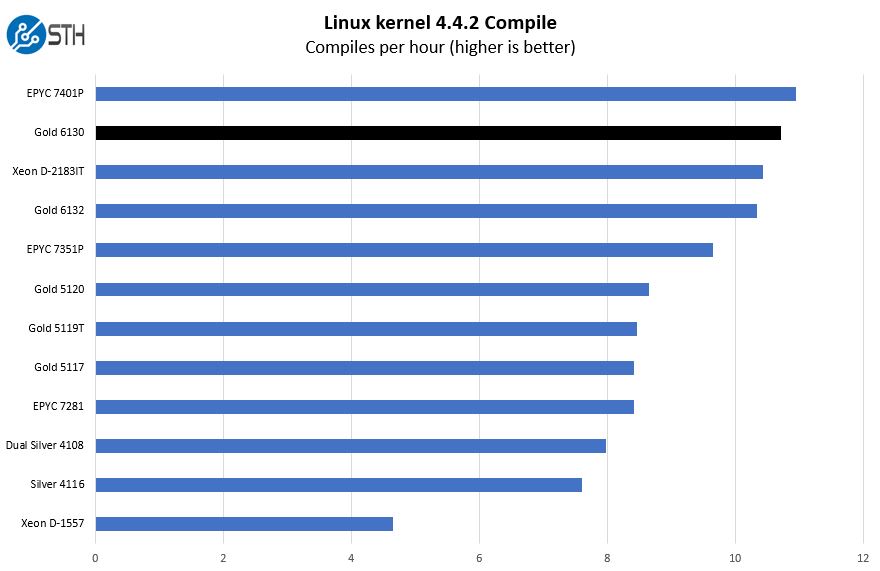
In this chart, we wanted to show a comparison group. We have the 16 core Intel Xeon D-2183IT to show the embedded competition. We also have the Intel Xeon Gold 5120 to show the series below. While the Xeon Gold 5120 is a formidable chip, it has two fewer cores, lower clock speeds and is limited to DDR4-2400. The Intel Xeon Gold 6130 supports DDR4-2666 and higher clock speeds. We also have the AMD EPYC competition, like the AMD EPYC 7401P to show core for core or performance per dollar.
c-ray 1.1 Performance
We have been using c-ray for our performance testing for years now. It is a ray tracing benchmark that is extremely popular to show differences in processors under multi-threaded workloads. We are using our new Linux-Bench2 8K render to show differences.
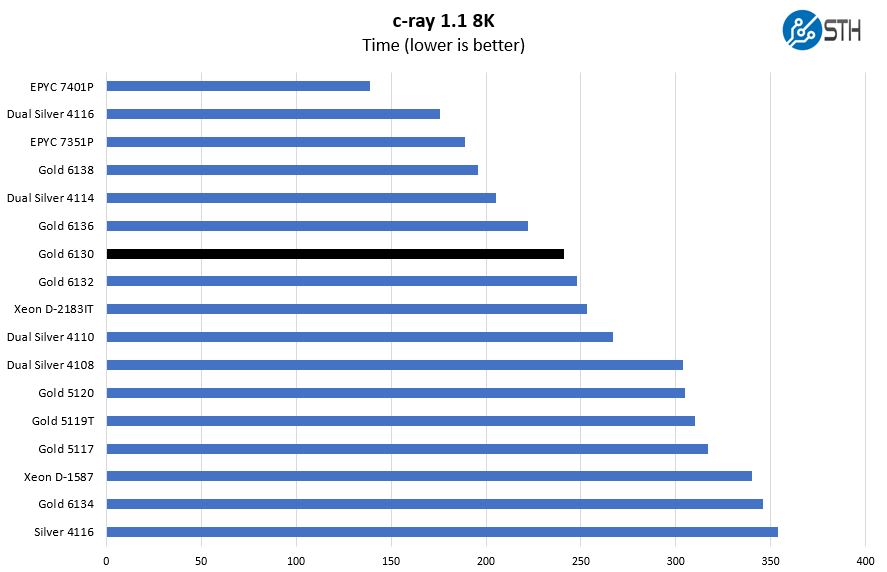
One nice feature of c-ray is that it does a fairly good job of scaling across cores and frequencies. That makes it extremely easy to see differences in CPUs. Here, one may find it strange that the Intel Xeon Gold 6130 outpaces the Xeon Gold 6132 and Gold 6134, but that makes sense as it has more cores than the higher numbered SKUs. The Intel Xeon Gold 6134 is a frequency optimized part with only eight cores or half of what the Gold 6130 has.
7-zip Compression Performance
7-zip is a widely used compression/ decompression program that works cross-platform. We started using the program during our early days with Windows testing. It is now part of Linux-Bench.
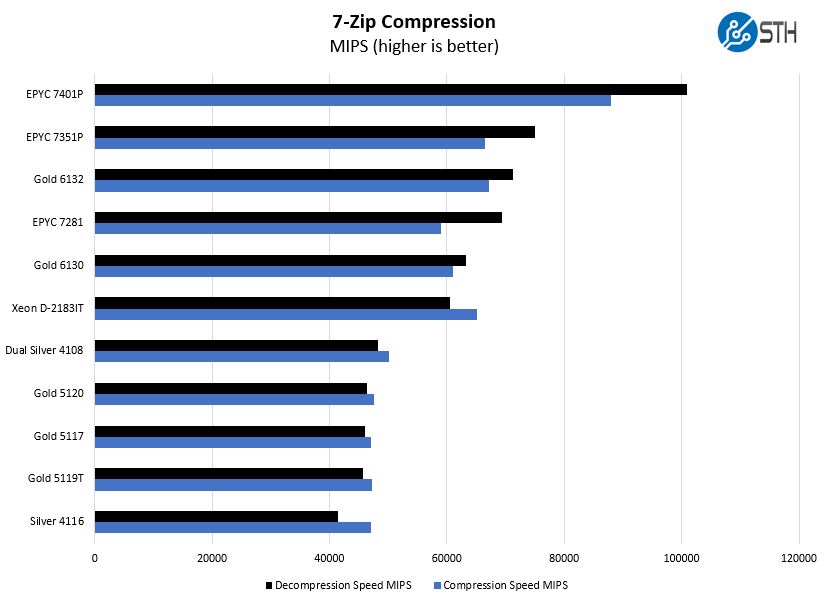
Here we can see the performance is about in the middle of our comparison group which is a solid result. Here the single Intel Xeon Gold 6130 is ahead of dual Intel Xeon Silver 4108 CPUs, the low-end 8-core chips with hyper-threading.
NAMD Performance
NAMD is a molecular modeling benchmark developed by the Theoretical and Computational Biophysics Group in the Beckman Institute for Advanced Science and Technology at the University of Illinois at Urbana-Champaign. More information on the benchmark can be found here. We are going to augment this with GROMACS in the next-generation Linux-Bench shortly. With GROMACS we have been working hard to support Intel’s Skylake AVX-512 and AVX2 supporting AMD Zen architecture. Here are the comparison results for the legacy data set:
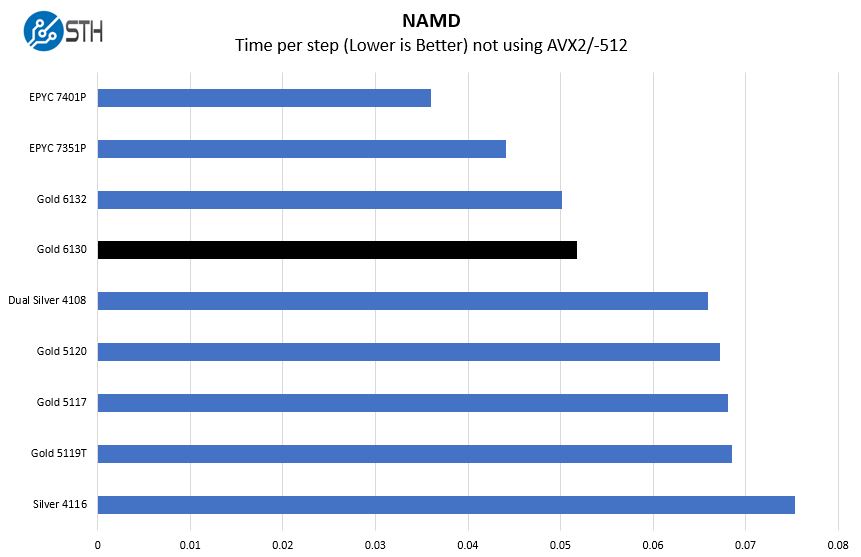
Without the use of AVX-512, we find the Intel Xeon Gold 6130 is a solid performer in NAMD, but AMD EPYC performs well here, even the 16-core AMD EPYC 7351P.
Sysbench CPU test
Sysbench is another one of those widely used Linux benchmarks. We specifically are using the CPU test, not the OLTP test that we use for some storage testing.
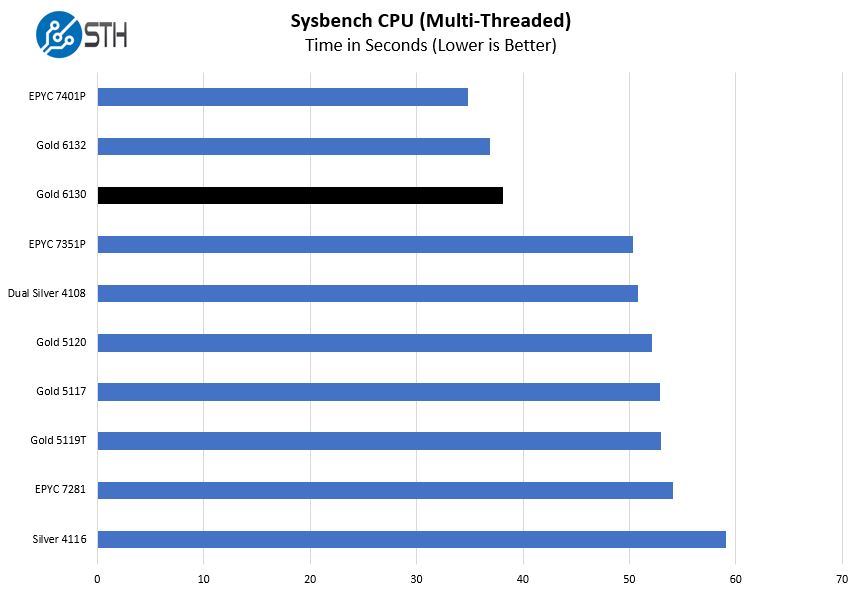
Even though AMD EPYC generally does well on this test, the Intel Xeon Gold 6130 performs well due to its higher clock speeds.
OpenSSL Performance
OpenSSL is widely used to secure communications between servers. This is an important protocol in many server stacks. We first look at our sign tests:
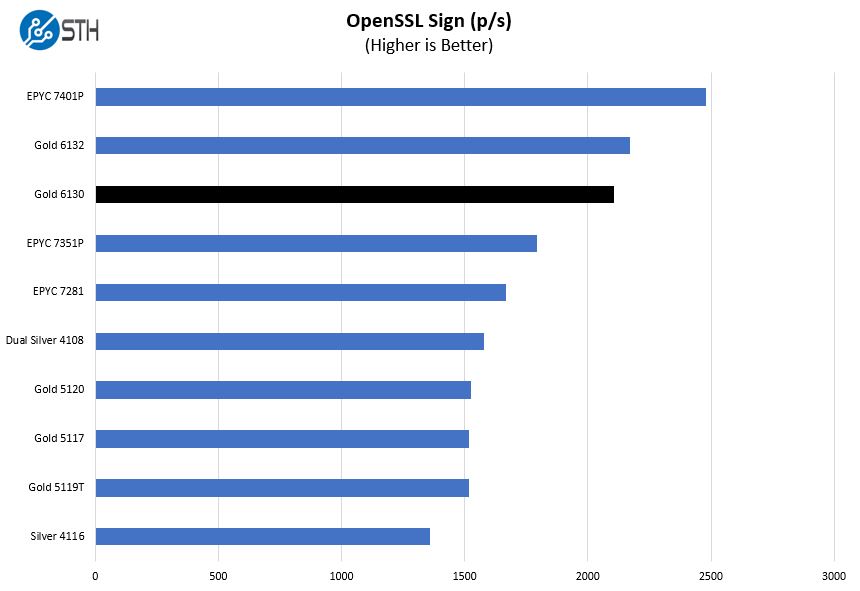
Here are the verify results:
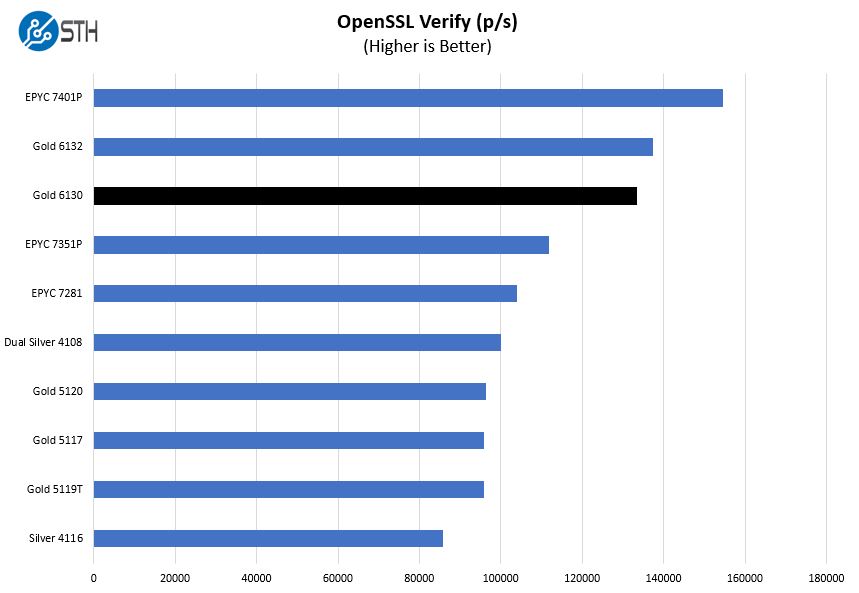
In our OpenSSL testing, we see strong performance from the Gold 6130 due to its relatively higher clock speeds. That puts the chip ahead of its AMD EPYC competition on a core per core basis.
UnixBench Dhrystone 2 and Whetstone Benchmarks
Some of the longest-running tests at STH are the venerable UnixBench 5.1.3 Dhrystone 2 and Whetstone results. They are certainly aging, however, we constantly get requests for them, and many angry notes when we leave them out. UnixBench is widely used so we are including it in this data set. Here are the Dhrystone 2 results:
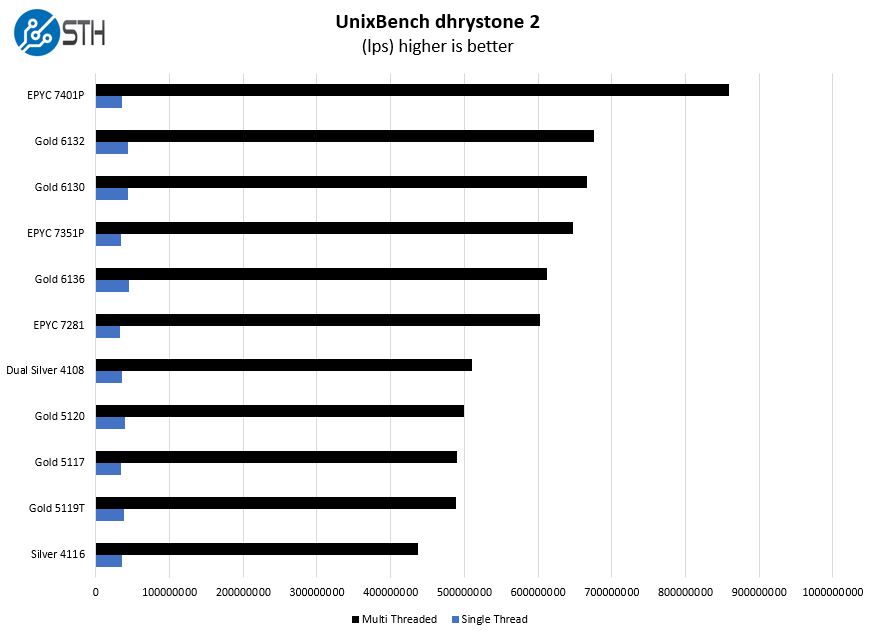
And the whetstone results:
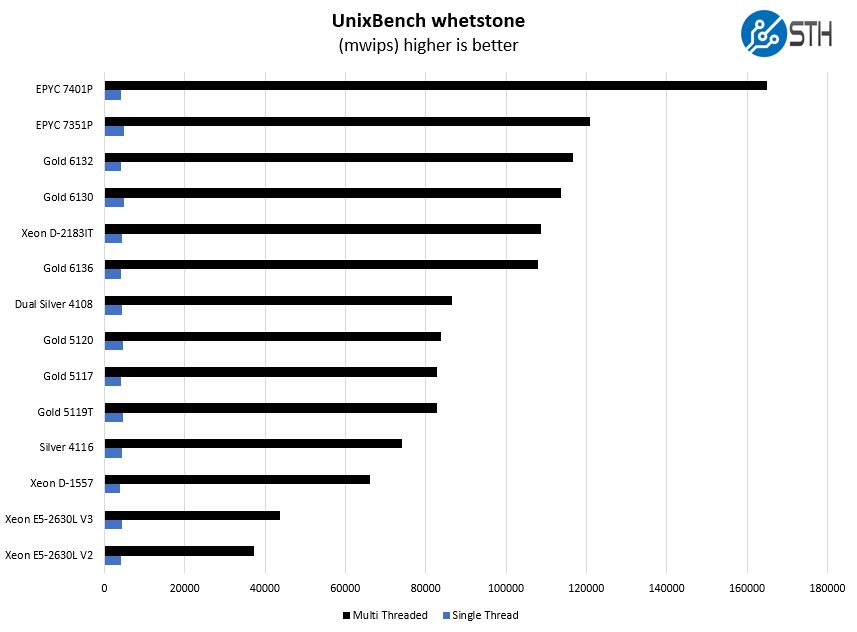
Here the AMD EPYC architecture performs very well and pulls victories in the performance per dollar category. The Intel Xeon Gold 6130 uses less power and has higher performance per core which makes it attractive in many situations.
GROMACS STH Small AVX2/ AVX-512 Enabled
We have a small GROMACS molecule simulation we previewed in the first AMD EPYC 7601 Linux benchmarks piece. In Linux-Bench2 we are using a “small” test for single and dual socket capable machines. Our medium test is more appropriate for higher-end dual and quad socket machines. Our GROMACS test will use the AVX-512 and AVX2 extensions if available.
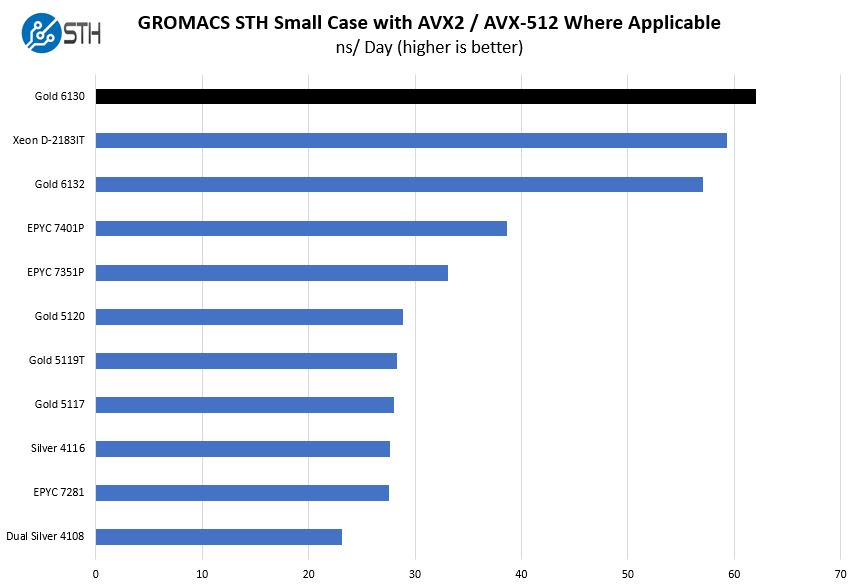
Then we have AVX-512. Here the Intel Xeon Gold 6130 performs extremely well due to its core count, its clock speed, and primarily its dual-port FMA AVX-512. That sets its performance in a league of its own, even besting a 32 core AMD EPYC platform (not shown on this chart but you can extrapolate from the 16 and 24 core results.) Another key point is to look at the Intel Xeon Gold 5100 series which falls flat regarding performance compared to the Intel Xeon Gold 6130. Dual port FMA AVX-512 is not available below the Intel Xeon Gold 6100 line so if you are using AVX-512 accelerated software, get a dual port FMA AVX-512 SKU like the Intel Xeon Gold 6130.
Chess Benchmarking
Chess is an interesting use case since it has almost unlimited complexity. Over the years, we have received some requests to bring back chess benchmarking. We have been profiling systems and are ready to start sharing results:
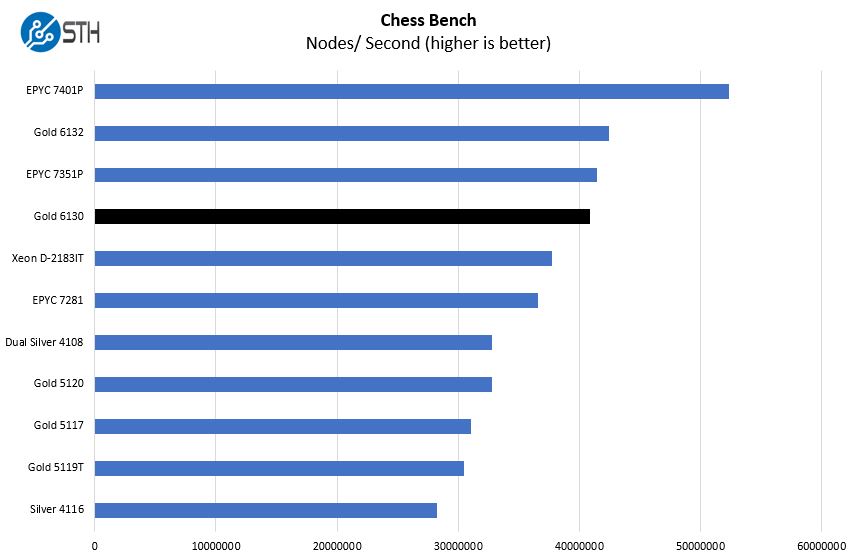
As you can see here, the performance is solid in this workload. It is far above the Intel Xeon Gold 5120 and similar to AMD EPYC regarding core-for-core performance.
We are going to discuss the Intel Xeon Gold 6130 power consumption, then follow that piece with some market analysis before giving our final thoughts on the processor.




When 256 GB of RAM is enough the Threadripper becomes a viable option in many cases with the introduction of samsung ECC U-DIMM DDR4-2666 CL19 32 GB sticks (Samsung model number: M378A4G43MB1-CTD).
TR2950X is half the price of a 6130 and in many cases a lot faster and it has 60 free PCIe 3.0 slots
Misha Engel – Threadripper / Threadripper 2 are not really competitors in the server space, even with low capacity 16GB UDIMMs. For the past few months, it has been hard to even get 4GB/ 8GB DDR4 RDIMMs. In the last week, we have added 260x DDR4 modules to the lab. 4x are 16GB, 256x are 32GB (48x 32GB RDIMM, 208x 32GB LRDIMM)
There may be a very niche market for a TR server, but without RDIMM support, and single-socket only support, it is a small niche. Single socket server sales are relatively small still.
AMD EPYC was also not a real competitor in the server market and we all know what going on at the moment.
It’s been hard to get any kind of memory for the last few months. ECC-U-DIMM 256 GB might not be perfect but it might be a start of something new. It happened before
There is something about the bar charts here that I think could be better. When a chart has one bar per CPU, the CPU-under-test has a black bar and the others have blue bars, which is great. But, when a chart has two bars per CPU, both colors are used for every CPU, and the CPU-under-test does not stand out, and I have to scan the labels to find it. It’s kind of inconsistent.
Misha, are you sure that M378A4G43MB1-CTD is ECC UDIMM? Can’t find it anywhere mentioned with ECC support. Thanks!
KarelG: Sorry it is M391A4G43MB1-CTD the other one is without ECC
Misha: Cool, this looks like it’s happenning at the end. Ryzen with 128GB, TR with 256GB, nice!
KarelG: If you want single core performance for per-core licensing(3.8 GHz all-core with a 9 cm Noctua air cooler), or a FreeNAS server or just a workstation with a lot of RAM this looks like a great option. And you also have the freedom to overclock those memory (both bandwidth and CL). Xeon-W is not going to like this.
Thanks for the very nice analysis of the Xeon Gold 6130. For single CPU systems, how would Gold 6130 compare with non-scaleable options such as Xeon W-2155?